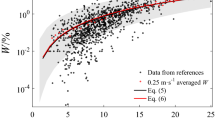Abstract
The pro and con of whitecap parameterizations and a statistical wave breaking model are discussed. An improved model is derived by combining satellite-based parameterization and the wave breaking model. The appropriate constants for the general wave state are obtained by considering the breaking condition of the wave slope and fitting with the satellite-based parameterization. The result is close to the constants based on the whitecap data from Monahan. Comparing with satellite-based data and the original model’s results, the improved model's results are consistent with satellite-based data and previous studies. The global seasonal distributions of the whitecap coverage averaged from 1998 to 2008 are presented. Spatial and seasonal features of the whitecap coverage are analyzed.
Similar content being viewed by others
References
Anguelova M D, Gaiser P W. 2011. Skin depth at microwave frequencies of sea foam layers with vertical profile of void fraction. Journal of Geophysical Research: Oceans (1978–2012), 116(C11): doi: 10.1029/2011JC00737
Anguelova M D, Webster F. 2006. Whitecap coverage from satellite measurements: a first step toward modeling the variability of oceanic whitecaps. Journal of Geophysical Research: Oceans (1978–2012), 111(C3): doi: 10.1029/2005JC003158
Asher W E, Karle L M, Higgins B J, et al. 1996. The influence of bubble plumes on air-seawater gas transfer velocities. Journal of Geophysical Research: Oceans (1978–2012), 101(C5): 12027–12041
Asher W E, Wanninkhof R. 1998. The effect of bubble-mediated gas transfer on purposeful dual-gaseous tracer experiments. Journal of Geophysical Research: Oceans (1978–2012), 103(C5): 10555–10560
Blanchard D C. 1963. The electrification of the atmosphere by particles from bubbles in the sea. Progress in Oceanography, 1: 73, 113–112, 202
Blanchard D C. 1983. The production, distribution, and bacterial enrichment of the sea-salt aerosol. In: Liss P S, Slinn W N, eds. Air-Sea Exchange of Gases and Particles. Netherlands: Springer, 407–454
Callaghan A, de Leeuw G, Cohen L, et al. 2008. Relationship of oceanic whitecap coverage to wind speed and wind history. Geophysical Research Letters, 35(23): doi: 10.1029/2008GL036165
Callaghan A H, White M. 2009. Automated processing of sea surface images for the determination of whitecap coverage. Journal of Atmospheric and Oceanic Technology, 26(2): 383–394
Cardone V J. 1969. Specification of the Wind Distribution in the Marine Boundary Layer for Wave Forecasting (No. GSL-TR-69–1). New York: Cardone
de Leeuw G, Andreas E L, Anguelova M D, et al. 2011. Production flux of sea spray aerosol. Reviews of Geophysics, 49(2): doi: 10.1029/2010RG000349
Erickson D J, Merrill J T, Duce R A. 1986. Seasonal estimates of global oceanic whitecap coverage. Journal of Geophysical Research: Oceans (1978–2012), 91(C11): 12975–12977
Goddijn-Murphy L, Woolf D K, Callaghan A H. 2011. Parameterizations and algorithms for oceanic whitecap coverage. Journal of Physical Oceanography, 41(4): 742–756
Hanson J L, Phillips O M. 1999. Wind sea growth and dissipation in the open ocean. Journal of Physical Oceanography, 29(8): 1633–1648
Monahan E C. 1971. Oceanic whitecaps. Journal of Physical Oceanography, 1(2): 139–144
Monahan E C, O’Muircheartaigh I G. 1980. Optimal power-law description of oceanic whitecap coverage dependence on wind speed. Journal of Physical Oceanography, 10(12): 2094–2099
Monahan E C, O’Muircheartaigh I G. 1986. Whitecaps and the passive remote sensing of the ocean surface. International Journal of Remote Sensing, 7(5): 627–642
Monahan E C, Spillane M C. 1984. The role of oceanic whitecaps in air-sea gas exchange. In: Brutsaert W, Jirka G H, eds. Gas Transfer at Water Surfaces. Netherlands: Springer, 495–503
Monahan E C, Woolf D K. 1989. Comments on “Variations of whitecap coverage with wind stress and water temperature”. Journal of Physical Oceanography, 19(5): 706–709
Salisbury D J, Anguelova M D, Brooks I M. 2013. On the variability of whitecap fraction using satellite-based observations. Journal of Geophysical Research: Oceans, 118(11): 6201–6222
Sayer A M, Thomas G E, Grainger R G. 2010. A sea surface reflectance model for (A) ATSR, and application to aerosol retrievals. Atmosphere Measurement Techniques, 3(4): 813–838
Stramska M, Petelski T. 2003. Observations of oceanic whitecaps in the north polar waters of the Atlantic. Journal of Geophysical Research: Oceans (1978–2012), 108(C3): doi: 10.1029/2002JC001321
Ulaby F T, Moore R K, Fung A K. 1981. Microwave Remote Sensing: Active and Passive. Volume 1-Microwave Remote Sensing Fundamentals and Radiometry. Reading, Mass: Addison-Wesley Publishing Company
Villarino R, Camps A, Vall-Ilossera M, et al. 2003. Sea foam effects on the brightness temperature at L-band. In: Proceedings of IEEE International Geoscience and Remote Sensing Symposium. Toulouse, France: IEEE, 5: 3076–3078
Wang Wei, Xu Delun, Lou Shunli. 1990. Directly synchronization measurement and results analysis of ocean whitecap and surface friction velocity. Haiyang Xuebao (in Chinese), 12(5): 638–647
Woolf D K. 2005. Parametrization of gas transfer velocities and seastate-dependent wave breaking. Tellus: B, 57(2): 87–94
Wu Jin. 1988. Variations of whitecap coverage with wind stress and water temperature. Journal of Physical Oceanography, 18(10): 1448–1453
Yuan Yeli, Han Lei, Hua Feng, et al. 2009. The statistical theory of breaking entrainment depth and surface whitecap coverage of real sea waves. Journal of Physical Oceanography, 39(1): 143–161
Zhang Xin. 2012. Contribution to the global air-sea CO2 exchange budget from asymmetric bubble-mediated gas transfer. Tellus: B, 64: doi: 10.3402/tellusb.v64i0.17260
Author information
Authors and Affiliations
Corresponding author
Additional information
Foundation item: The National Key Basic Research Program (973 Program) of China under contract No.2010CB950404; the National High Technology Research and Development Program (863 Program) of China under contract No.2013AA09A506; the Basic Scientific Fund for National Public Research Institutes of China under contract No.GY0214G01; the Ocean Renewable Energy Special Fund Project of the State Oceanic Administration of China under contract No.GHME2011ZC07.
Rights and permissions
About this article
Cite this article
Ren, D., Hua, F., Yang, Y. et al. The improved model of estimating global whitecap coverage based on satellite data. Acta Oceanol. Sin. 35, 66–72 (2016). https://doi.org/10.1007/s13131-016-0848-3
Received:
Accepted:
Published:
Issue Date:
DOI: https://doi.org/10.1007/s13131-016-0848-3



